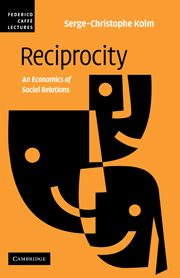Book contents
- Frontmatter
- Contents
- List of illustrations
- Foreword
- Introduction
- Part I Facts and forms
- Part II Motives
- Part III Values and reasons
- Part IV The economics of reciprocity
- 17 General methodology of reciprocity analysis
- 18 The theory of comparative, matching, or balance reciprocity
- 19 The theory of liking reciprocity
- 20 Strategic interaction and process preferences: games of reciprocity
- 21 General properties of processes
- 22 Solutions of reciprocity games; comparisons
- 23 Reciprocity in the understanding of society and its economy
- Bibliography
- Index
21 - General properties of processes
Published online by Cambridge University Press: 22 September 2009
- Frontmatter
- Contents
- List of illustrations
- Foreword
- Introduction
- Part I Facts and forms
- Part II Motives
- Part III Values and reasons
- Part IV The economics of reciprocity
- 17 General methodology of reciprocity analysis
- 18 The theory of comparative, matching, or balance reciprocity
- 19 The theory of liking reciprocity
- 20 Strategic interaction and process preferences: games of reciprocity
- 21 General properties of processes
- 22 Solutions of reciprocity games; comparisons
- 23 Reciprocity in the understanding of society and its economy
- Bibliography
- Index
Summary
General preferences
Transfers, process and preferences
Let variable x ∈ X denote the set of transfers, from and to any agent (these distinctions will come later). As noted, x also entails the final allocation, and the “allocative preferences” can be about both the transfers per se and the resulting allocation. Variable z ∈ Z denotes a type of process, and hence both a type of “mechanism” leading to a solution, and the type of social relations that accompany it. An agent's (overall) preferences are concerned with the pairs (x, z). Classically, these preferences will be assumed to constitute a preordering with pairwise relations denoted as ≻ (preference), (indifference), and ≻̰ (≻ or ~). These preferences are often representable by an ordinal utility function u(x, z), and we will often consider this representation for convenience. These preferences, considered for all involved agents, will be used to explain the outcome x of each type of process z; the emergence of a specific process z; the normative evaluation and comparison of the processes; and the evaluation of the realized solution among them.
Intrinsic process preference and a basic lemma
Let us first point out a basic general property. Assume that x and x′ ∈ X, z and z′ ∈ Z, and (x′, z′) ≻̰ (x, z). Then, (x, z) ≻ (x, z′) implies (x′, z′) ≻ (x, z′), and (x′, z) ≻ (x′, z′) implies (x′, z) ≻ (x, z).
Information
- Type
- Chapter
- Information
- ReciprocityAn Economics of Social Relations, pp. 290 - 297Publisher: Cambridge University PressPrint publication year: 2008
